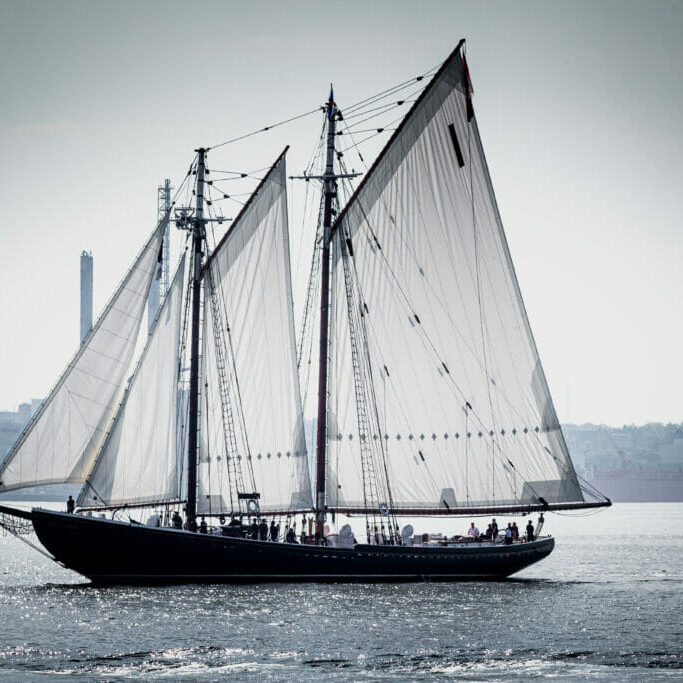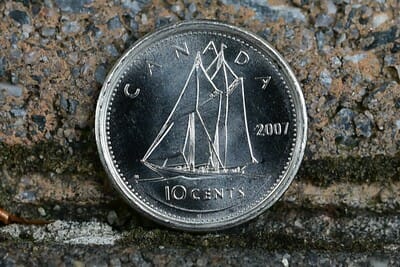

A century ago a Nova Scotia fishing schooner, that would live on for generations in the pockets and coin purses of Canadians, was launched at the Smith and Rhuland Shipyard in Lunenburg N.S.
On March 26, 1921, Nova Scotians first met the Bluenose, the ship on the Canadian dime. The ship was designed to be faster and more competitive in Atlantic fisheries and in international fisherman’s races. The project cost $35,000 in 1921, which is almost $450,000 in today’s dollars when adjusted for inflation. It was led by captain Angus Walters, self-taught marine architect William J. Roué and four businessmen.
The Bluenose captured its first victory at the 1921 International Fishermen’s Race and won race after race for a decade, only once defeated by the Gertrude L. Thebaud from Boston.
Now at the 100-year anniversary of the boat’s launch and victory, the Bluenose 100 committee is hosting a series of virtual events to educate Nova Scotians about the ship’s story.
“I think for whatever reason people really clung to the image, the success and the pride of Bluenose, and they made it an icon,” said Emily Sollows, communications representative and assistant of operations on Bluenose II and at the Bluenose 100 committee.
Celebrating the icon

The Bluenose 100 Committee will hold weekly Bluenose-themed livestreams throughout the year to revisit the beginnings of the ship, said Sollows.
Like most recent events, the COVID-19 pandemic forced them to change course.
“There was an initial disappointment to transitioning to virtual events,” Sollows said. “But ultimately we realized that we’re going to be able to reach a much larger audience.”
The virtual events will include interviews with people familiar with Bluenose’s history, like Adrian Morrison, the curator of the Fisheries Museum of the Atlantic in Lunenburg, N.S. as well as interviews with those connected to the ship’s main characters, such as Joan Roué, great-granddaughter of the ship’s original architect.
“They are the descendants and with the story being so iconic, they were told lots of Bluenose stories growing up. So, they’re quite knowledgeable about the story and their grandparents’ roles,” Sollows said.
The Bluenose legacy lives on
Nicknamed the Queen of the North Atlantic Fishing Fleet, the boat represented the province’s importance in the international fishing industry, according to the Nova Scotia Archives website.
But in the 1930s, mechanical schooners became more popular, signalling the end of the Bluenose’s dominance as a sail-powered vessel, according to Sollows. The Bluenose then travelled as a showboat until it was sold to the West Indian Trading Company for use transporting goods in the Caribbean. The legendary schooner hit a coral reef and sunk near Haiti in 1946.
Almost 20 years after the Bluenose’s shipwreck, in 1963 the Oland Brewery in Halifax built the Bluenose II in consultation with William J. Roué and captain Walters. The $300,000 construction, which would cost $2.5 million today, allowed Nova Scotia’s coasts to see their beloved schooner’s silhouette return.
“The sight of a proud fishing schooner sliding gracefully down the ways into Lunenburg harbour brought to life once more the memories and legends of an era, gone but far from forgotten,” read an article in Le Canadien on Sept. 3, 1963.
The Bluenose’s replica was gifted to the Government of Nova Scotia eight years after its creation. Since then, it has served as an ambassador for the province.
Pictured on the Canadian dime, the ship lives on thanks to captain Phil Watson and his crew, who sail the ship across Atlantic Canada during the summers.
“Bluenose II is not a museum exhibit behind glass,” said Watson. “She is an artifact that can travel, and interact with people in their communities and within their cultural reference.”
Watson has been at the helm of the Bluenose II for 20 years after starting out as a deckhand in 1987. To him, the Bluenose includes all the ingredients of a great classic tale.
“Man against nature. Man against each other. Nation against nation. All represented by characters who are relatable,” he said.
According to Watson, the hull and rig of the replica are about as close to the original Bluenose as one can get. But the construction of the Bluenose II followed modern regulations for the interior and engines.
“The experience of sailing her is largely the same, but we have showers, toilets and radios, and all the things that captain Angus did not have,” he said.
After growing up in Mahone Bay, N.S. outside of Lunenburg and joining the ship’s crew as a deckhand, Watson accomplished his dream of captaining this ship in 2001.
“Taking the Bluenose II back to Mahone Bay is like taking the Stanley Cup back to your hometown,” he said. “It’s the dreams of a little kid come true.”
Despite the childlike wonder that can come with the job, Watson takes his responsibility to Canadian’s seriously.
“The crew and I are the caretakers of a representation of a great story in Canadian history,” he said. “We also represent the people of Nova Scotia and their stories.”
A symbol of hope 100 years later
Sollows, who has crewed for two years with Watson, said the original Bluenose was built during difficult times. The Spanish influenza pandemic still lingered and the First World War had just ended. The Bluenose “really represented hope and resilience” at that time, she said.
According to Sollows, it still does.
“Our sail last summer in 2020 was to help raise the spirits of Nova Scotians,” Sollows said, after the province experienced the worst mass shooting in Canadian history in April 2020. “It became very apparent to us that seeing a symbol of the past sailing across the province, a Canadian icon, was really meaningful to people.”
Both she and captain Watson said they doubt there will ever be another vessel so emblematic to the province.
“Bluenose and captain Angus still have lessons to teach us,” Watson said.






